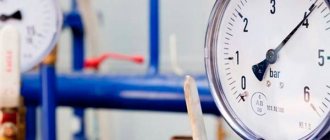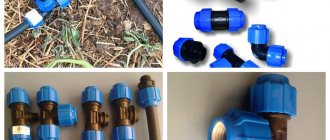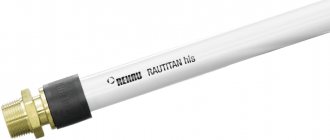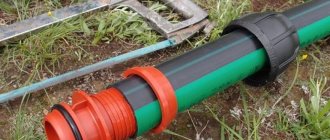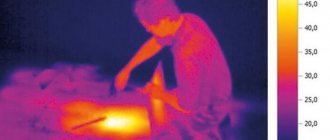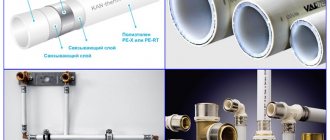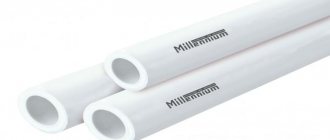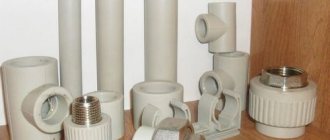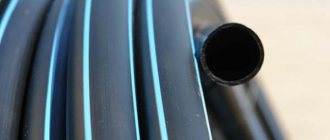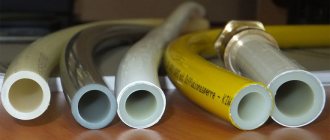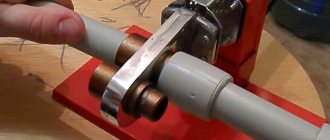A fitting is a narrow-profile engineering product used for connecting, branching, turning a pipeline and transitioning to another diameter, as well as connecting shut-off and control valves and heating devices to pipes. Fittings are widely used on all types of pipelines and are classified according to the method of installation.
The pipeline assembled using fittings is very easy to disassemble in the future, which facilitates the process of repair and flushing if necessary. The system can also be easily upgraded by simply replacing the valve element or regulator.
In this article we will look at the types and features of fittings from the manufacturer MPF, as well as products that may be required during installation.
MPF threaded connections are made of brass grade CW617N (LS 59-3) using hot die forging. The chemical composition of CW617N brass allows us to obtain products with an optimal ratio of strength and ductility. An increase in the amount of lead in the alloy leads to a decrease in strength and hardness. As the tin content increases, the ductility decreases and the product becomes brittle.
Composition of brass CW617N:
- Cu (Copper) 57-59%
- Sn (Tin) 0.3%
- Fe (Iron) 0.3%
- Al (Aluminium) 0.05%
- Pb (Lead) 1.6-2.6%
- Ni (Nickel) 0.3%
- Zn (Zinc) – the rest.
All MPF fittings have an additional nickel-plated coating with a thickness of at least 7 microns over the entire surface of the product, which provides additional protection to the brass from washing out individual elements, and also ensures a pleasant appearance of the product.
Nickel plating is carried out using the latest equipment, due to which the fitting acquires a shiny, sometimes mirror-like surface similar to chrome.
Areas of application
Connecting threaded parts perform various tasks in a pipeline system: they connect two pipes ending in threads or pipes with shut-off valves, redirect and separate the flow of the working medium, serve as adapters between parts of different diameters or materials, and can also close the system.
Fittings are used wherever there is water supply: in industry, residential buildings, agriculture, transport, urban infrastructure, as well as in any cold and hot water supply, heating and gas supply systems.
All connectors with external threads under the MPF brand have notches on the threads that prevent the sealing material from slipping during installation.
Types of fittings
The industry produces a huge number of connectors of various designs and specifications. We will look at the most popular fittings of our own production, their types and purposes.
Nipple (barrel)
- has two external threads of the same size.
Designed for connecting parts with internal threads of the same size. Transitional nipple (barrel)
- has two external threads of different sizes. Designed for connecting parts with internal threads of different sizes.
coupling
- has two internal threads. Designed to connect two parts with external threads of the same size.
Hex coupling
- has two internal threads. Designed to connect two parts with external threads of the same size. The hexagonal coupling allows installation using a conventional open-end wrench. It is a unique product developed and produced only by MasterProf.
Transitional coupling
- has two internal threads of different sizes. Designed to connect two parts with external threads of different sizes. It also has a hexagon on the body for gripping with an open-end wrench.
Futorka
is an adapter that has internal and external threads, in which
the diameter of the external thread is always larger than the internal one
. For example, a 1/2 by 3/4 fitting means that the internal thread diameter is 1/2 inch and the external thread diameter is 3/4 inch.
Adapter
- this is the same fitting, only the diameter of the internal thread is always larger than the external one. For example, a 1/2 to 3/4 adapter means that the diameter of the internal thread is 3/4 inch and the external thread is 1/2 inch.
I/O elbow
— Needed to connect two sections of pipeline at an angle of 90*. Has two internal threads of the same size.
I/O transition elbow
— Needed to connect two sections of pipeline at an angle of 90*. Has two internal threads of different sizes.
Square with limiter in/n
— Needed to connect two sections of pipeline at an angle of 90*. Has one internal and one external thread of the same size. The limiter is designed to prevent the sealing material from being squeezed out during installation.
Transition elbow
— Needed to connect two sections of pipeline at an angle of 90*. Has one internal and one external thread of different sizes. The limiter is designed to prevent the sealing material from being squeezed out during installation.
Square n/n
— Needed to connect two sections of pipeline at an angle of 90*. Has two external threads of the same size.
Transition elbow n/n
— Needed to connect two sections of pipeline at an angle of 90*. Has two external threads of different sizes.
I/O elbow with fastening (Water socket)
— a square with the possibility of fastening to the wall. The elbow has two internal or one internal and one external threads of the same size. Usually used for installing a mixer or water shut-off valves (taps for stationary appliances).
Tee in/out/in
— A pipeline connecting piece with three internal holes of the same thread size, allowing an additional branch to be connected to the main pipe.
Tee n/n/n
— a connecting part of a pipeline with three external threads of the same thread size, allowing you to connect an additional branch to the main pipe.
Tee w/n/n
— serves for branching flows at an angle of 90°C in 1/2″ pipelines with internal and external threads made of brass and steel, as well as in combined pipelines where there is a threaded connection.
Tee n/v/n
— A connecting part of a pipeline with two external threads and a branch with an internal thread, the same thread size, allowing you to connect an additional branch with an internal thread to the main pipe.
Tee in/out/in
— A connecting part of a pipeline with two internal holes and a branch with an external thread, the same thread size, allowing an additional branch with an internal thread to be connected to the main pipe.
Transition tee in/out/in
— example 1x1/2x1 allows you to connect a pipeline of a smaller diameter to a larger one without resorting to installing additional adapters.
Cross
— the functionality is similar to that of a tee, only there are two branches. A pipeline connecting piece with four internal holes of the same thread size, allowing two additional branches to be connected to the main pipe.
Sgon "American"
- a connecting element that allows, using just one key, to unscrew the union nut and disassemble or assemble two fixed parts of the pipeline.
Sgon "American" v/n
- this is a connecting product, thanks to which you can quickly and conveniently assemble or disassemble a pipeline from various materials with internal or external threads using one key. The product itself structurally consists of a quick-release nut, two threaded fittings and an EPDM gasket.
Sgon "American" corner v/n
is a connecting product, thanks to which you can quickly and conveniently assemble or disassemble pipelines at an angle of 90* from various materials with internal or external threads using one key. The product itself structurally consists of a quick-release nut, two threaded fittings and an EPDM gasket.
Sgon "American" n/n
- this is a connecting product, thanks to which you can quickly and conveniently assemble or disassemble pipelines from various materials with internal threads using one key. The product itself structurally consists of a quick-release nut, two threaded fittings and an EPDM gasket.
Plug with internal thread
— designed for sealing an open section of a pipeline with external thread. Used with sealing materials or gasket.
Plug with external thread (Plug)
— designed for sealing an open section of a pipeline with internal threads. Used with sealing materials.
Lock-nut
— used in conjunction with a drive to tighten the coupling.
Locknut with flange
— used together with a drive to tighten the coupling. The limiter is designed to prevent the sealing material from being squeezed out during installation.
Extension
— a connecting element for pipelines made of chrome-plated brass, which is a cylinder with internal and external threads of the same diameter.
Thanks to the chrome coating, it goes well with chrome-plated sanitary
ware (towel rails, faucets, etc.). Nickel-plated hexagonal extensions are available. Extensions come in different lengths from 10 - 100 mm. thread diameter 1/2″, ¾”, 1”. Most often, extension cords are used when installing faucets and heated towel rails. Using extensions, they compensate for the thickness of the plaster or tiles laid on the wall.
Sgon
- a piece of pipe with threads cut on both sides. Used to connect two fixed sections of a pipeline. On the one hand, the length of the thread is longer than on the other side, this was done due to the peculiarities of installing the outlet on the pipeline.
Material for an important part
The classification of fittings by material of manufacture is as broad as by place of application. Due to the fact that pipes made of different materials have to be connected using fittings, they are made from steel, cast iron, brass, metal-plastic, PVC, stainless steel, nickel, polypropylene and even polyethylene.
Do not forget that fittings made from different materials have their own characteristics and vary in quality. For a certain type of pipe, you need to select fittings from the appropriate material. This will simplify your work and increase the service life of the highway you have made.
How to install a squeegee
To connect two sections of a fixed pipeline, a bend of the required length is selected (equal to the length of the pipeline rupture). We screw the locknut onto the long thread, then the coupling. We screw the short thread into one of the stationary parts of the pipeline, twist the coupling from the long thread and screw it onto the pipeline to be connected (the gap between the pipeline and the outlet is in the middle of the coupling), tighten the coupling with a locknut. The connection is ready. Be sure to use sealing materials!
Extension barrel
- a special type of fitting that is necessary to increase the length of individual elements of the pipeline system.
Drainage (Repair insert, brass clip (drainage, saddle))
used when it becomes necessary to connect a pipe or fittings to an existing steel pipeline. By choosing this fitting, you will not need welding or threading work. The sealing collar is made of high-quality synthetic EPDM rubber, and the thread of the pipe is made in accordance with GOST 6357. The collar is designed for use at temperatures from –20 to +90 °C, operating pressure up to 10 (test – 15) bar.
Union
- used to connect a threaded connection with a flexible hose in household plumbing, garden, etc. The fitting has an external or internal thread. Thread size range from 3/8″ to 2″ or more. Our range includes 1/2″, 3/4″, 1″. The fittings can be nickel plated or unplated (yellow). The most common option is a fitting for the drain hose of a washing machine and a fitting for a watering hose.
Adapter for Eurocone
- used for connecting metal-polymer pipes directly to shut-off and control valves or manifolds
Fitting (inset) into the tank (container) with gasket (brass)
. This type of fitting is used to connect a tank or barrel to the water supply network. The design consists of a fitting, two gaskets and a clamping nut. It is especially popular among summer residents and gardeners for organizing watering of plants from a barrel.
Installation stages
To install polypropylene pipes, it is better to rent a special soldering iron. You will also need a pipe cutter (or a hacksaw), a marker, a protractor or an angled ruler. For a complete set of tools, you need to prepare an adjustable wrench.
There are no special technological subtleties in the process of installing polypropylene pipes, however, if there is a complete lack of operational skills, difficulties may arise with the operation of the pipeline in the future. Sequencing:
- Cut off a section of pipe.
- Clean the cut area from burrs.
- Select and adjust the required fitting.
- Place the appropriate nozzle on the polypropylene soldering iron.
- Turn on the device and wait for it to heat up.
- At the same time, insert the end of the pipe and the connecting element into the soldering iron nozzle, and then wait a few seconds (the time depends on the wall thickness).
- Remove the fitting and section of water supply from the nozzle and connect manually, inserting one element into the other until it stops.
The peculiarity of installing a polypropylene water supply system is the need to quickly perform all actions.
How to install a tap into a tank
Initially, before installation, it is necessary to make a hole of a certain size in the tank, taking into account the threaded part. Next, you will need to install the main part of the insert with a gasket on the inside of the tank, the second gasket seals the system from the outside. The next step is to secure the nut and attach the tap, fitting and other elements.
The insert makes it possible to connect any threaded connection (hose fitting, water shut-off valve, etc.) to the container (tank). MPF tank taps have an advantage over other manufacturers - in addition to the external thread, the fitting also has an internal thread, which allows the use of a connection with an external thread. For example, a 3/4″ insert has a 1/2″ internal thread, and a 1″ insert has a 3/4″ internal thread.
Advantages
Advantages of using MPF fittings for installation:
- High quality CW617N brass ensures high reliability of the fitting;
- The reduced lead content allows the fittings to be used for drinking water;
- Nickel plating over the entire surface of the product prevents the washing out of individual alloy elements;
- Excellent appearance of the product thanks to high-tech application;
- Corrosion resistance;
- Unique design features in most products.
Types by installation method
There are many types of fittings that differ from each other in the way they are connected. They can be classified into flanged, threaded, welded, compression and press fittings.
Compression fittings.
It is a simple type of connection, which is most often used when installing straight sections. The tightness of such connections is achieved by using seals. Compression fittings are inferior in strength to welded or threaded connections and are not used in hot water supply systems.
Threaded.
Such fittings can withstand heavy loads and are a collapsible connection that can be easily dismantled.
Flanged.
They are disks that are secured by welding or threading. A gasket is installed between the disks, after which they are tightened with bolts.
Welded structures.
A non-separable, hermetic and durable connection, which is most often used when installing pipelines with increased requirements.
Press fittings.
This type of fitting is durable and is a collapsible connection that can be easily mounted and dismantled without the use of additional tools or a welding machine. The principle of connection is to install two sleeves and several gaskets, which are fixed using press pliers.
Specifications
When creating water supply systems, polypropylene pipes are often used. The requirements for them are described in GOST 32415-2013. Main characteristics:
- Density – 0.91 kg/cm3. Despite the fact that the indicator is minimal compared to similar materials, the products are distinguished by high strength and hardness. In addition, polypropylene is resistant to abrasion, due to which it tolerates the effects of abrasive particles well.
- Low thermal conductivity coefficient. Condensation does not accumulate on the surface.
- High strength. However, sharp bends and strong pressure lead to cracks. The shape of products must be changed slowly.
- Resistance to destruction in aggressive environments. The risk of damage to the material occurs when interacting with strong acids, or during prolonged heating.
The dimensions of propylene pipes and fittings for water supply depend on the material of manufacture (PPR, PPH, PPB, PPS) and can range from 16 to 1200 mm.
Selection and installation of fittings
The durability and reliability of the piping directly depends on the quality of the selected fittings, so it is important to choose quality products. Also, when choosing products, you should pay attention to the following factors:
- The cross-sectional size of the fitting must match the cross-sectional size of the pipe;
- When comparing two similar fittings, choose the heavier one;
- Choose a coated fitting over an uncoated brass fitting. Nickel plating provides additional protection to the fitting;
- Choose a fitting with notches on the external threads to make it easier to apply sealing material;
- The connection method should be selected based on the possible loads to which the part will be subjected;
- Reliable manufacturers of fittings are the key to durable and reliable operation;
- Pay attention to the surface. It should not have roughness, sagging or poorly processed seams.
One coupling, two tees - you get a water supply system
Fittings, despite their ease of use, have many advantages. They do not require welding. Very quick and easy to install. They simplify the connection of pipes made of different materials (for example, metal-plastic and steel).
And most importantly, you don’t need to have any special skills to work with fittings. You need desire, patience, and your completed work will pleasantly surprise you. If you still doubt your professionalism, try looking at all of the above elements in the store. Ask your consultant to help you and explain the difference.
The question “What is a fitting?” We have sorted it out, and now I would like to remind you of one rule of good plumbing: if a high-quality fitting is used, then the system will be reliable and durable.
It’s so nice to make your own plumbing or drip irrigation in your dacha, install a faucet without calling a plumber, or even just change the meter yourself.
Fittings supplier
is a manufacturer of high quality brass fittings made from CW617N brass with reduced lead content. Our priority is not the pursuit of low prices, but the sale of high-quality and safe products on the Russian engineering market. That is why the company places great importance on analyzing the plumbing market. We provide a detailed price list for all our products at your request, have ample options for payment and delivery, and also provide advice on any issue.
began its activities in 2012 and today has its own production, warehouses and well-established logistics. We are a reliable manufacturer of high quality low lead brass fittings. The company's priority is not the pursuit of low prices, but the supply of high-quality and safe products to plumbing stores and chain construction hypermarkets. We provide a detailed price list for all our products upon request, and also have extensive payment and delivery options.
Over the years, we have established partnerships with many stores and suppliers. Examples of our work.
Our specialists will help you organize your own business and select the necessary products.
Still have questions? Call or write - we will answer. Phone E-mail Address: St. Petersburg, st. Zastavskaya, 5/1.
